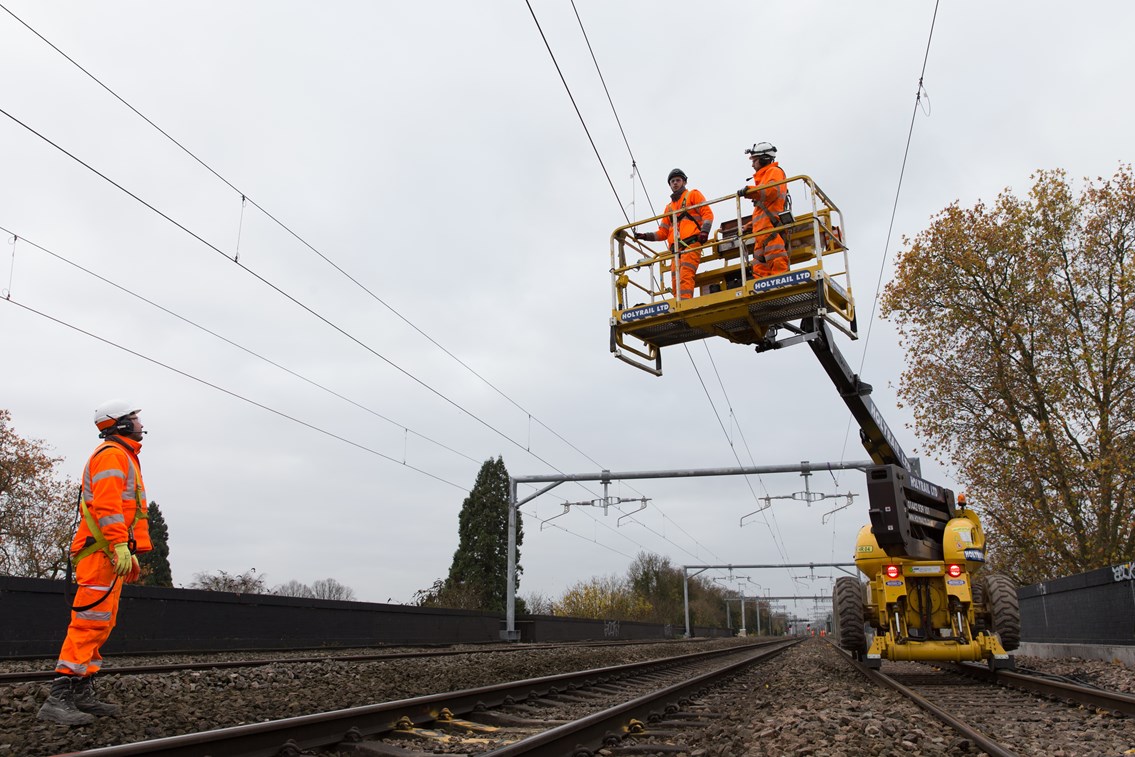Friday 9 Dec 2016
First electric wires for Crossrail programme switched on in Thames Valley
- Region & Route:
- | Southern
Thames Valley rail passengers can look forward to better journeys and the introduction of new GWR trains in 2017 following the achievement of the latest milestone in the electrification of the railway between Heathrow junction and Maidenhead by Network Rail as part of the Crossrail programme.
- 12 miles of railway between Maidenhead and Heathrow junction being electrified by Network Rail as part of the Crossrail project
- Work to install overhead line equipment nearing completion - 80% of overhead wires are now installed and first section turned on
- Electrification paves the way for new Great Western Railway (GWR) trains in 2017 and Elizabeth line services in 2019
Thames Valley rail passengers can look forward to better journeys and the introduction of new GWR trains in 2017 following the achievement of the latest milestone in the electrification of the railway between Heathrow junction and Maidenhead by Network Rail as part of the Crossrail programme.
After more than a year of work, the electricity has now been turned on along the first section. The remaining section will be turned on next year allowing new electric GWR trains to run between Maidenhead and London Paddington from summer 2017.
The work is part of the Crossrail programme and Network Rail’s Railway Upgrade Plan to provide a bigger, better, more reliable railway for passengers and businesses.
To bring passengers quieter, greener and more efficient journeys, Network Rail has carried out this major infrastructure investment programme, allowing the introduction of the Elizabeth line trains and GWR’s electric trains to the Thames Valley.
Electrification to power the new trains requires the installation of overhead line equipment alongside and above the existing track. It consists of overhead wires running between supporting steel posts to distribute electricity. The steel posts are mounted on heavy duty foundations.
An 800-strong workforce has successfully installed over 1,400 piled foundations and 834 overhead line structures. More than three quarters of the wiring programme, which sees 150km of wires strung between the new equipment, has now been completed.
From summer 2017, GWR will be able to extend its electric train services to Maidenhead, which currently stop at Hayes & Harlington. When the Elizabeth line opens fully in December 2019, passengers in the Thames Valley will be able to travel on new trains right through central London without having to change at Paddington.
Matthew Steele, Network Rail Project Director, said: “This is a key milestone towards the introduction of brand new, cleaner, quieter electric trains on this very busy route into London. This electrification not only enables the introduction of the Elizabeth line but also supports the introduction of new GWR trains in 2017.
“I would like to thank the local residents and businesses for their patience as we undertake this sometimes noisy construction works”.
Matthew White, Crossrail Surface Director, said: “This vital work is paving the way for quicker, greener, quieter and more reliable trains for people in the Thames Valley. Once the Elizabeth line opens fully, passengers will be able to travel right through the capital without having to change at Paddington, making it quicker and easier to get to a range of destinations across London and the South East.”
Contact information
Passengers / community members
Network Rail national helpline
03457 11 41 41
Latest travel advice
Please visit National Rail Enquiries
Journalists
Network Rail press office - Richard Griffiths
Network Rail
07734 649189
Richard.Griffiths@networkrail.co.uk
About Network Rail
We own, operate and develop Britain's railway infrastructure; that's 20,000 miles of track, 30,000 bridges, tunnels and viaducts and the thousands of signals, level crossings and stations. We run 20 of the UK's largest stations while all the others, over 2,500, are run by the country's train operating companies.
Usually, there are almost five million journeys made in the UK and over 600 freight trains run on the network. People depend on Britain's railway for their daily commute, to visit friends and loved ones and to get them home safe every day. Our role is to deliver a safe and reliable railway, so we carefully manage and deliver thousands of projects every year that form part of the multi-billion pound Railway Upgrade Plan, to grow and expand the nation's railway network to respond to the tremendous growth and demand the railway has experienced - a doubling of passenger journeys over the past 20 years.
Follow us on Twitter: @networkrail
Visit our online newsroom: www.networkrailmediacentre.co.uk

